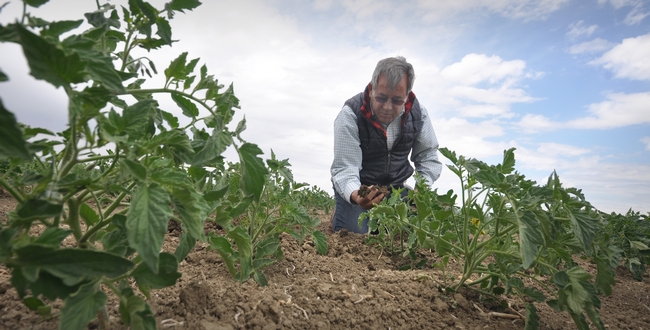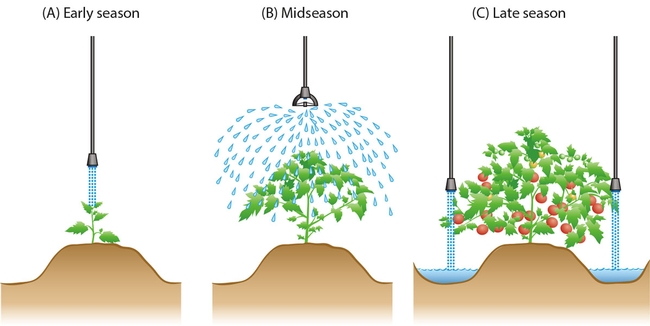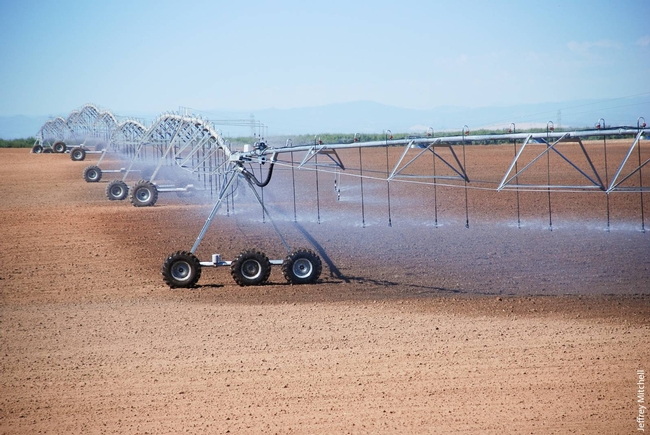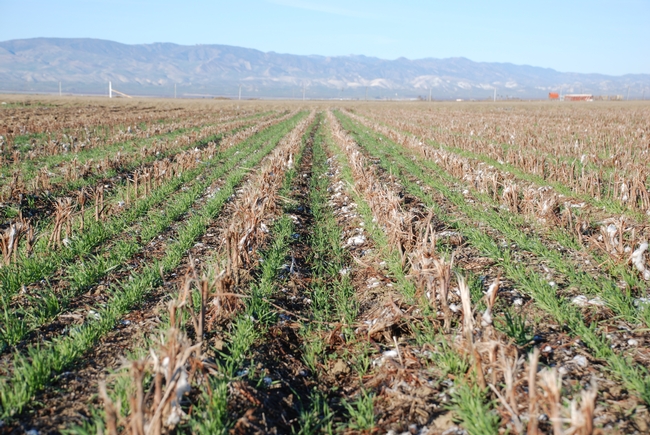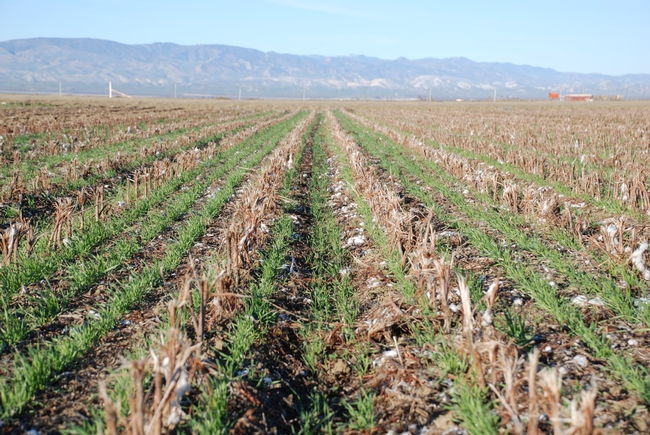Posts Tagged: conservation agriculture
With conservation agriculture, Firebaugh farmers use half the nitrogen and a third less water
How do you cut your water use by a third, cut your nitrogen use in half, maintain your tomato yield and improve your fruit quality?
“With patience, perseverance and by treating your soil like a living ecosystem — which it is,” says Jesse Sanchez.
Sanchez should know. He and Alan Sano have been experimenting with soil enhancements for 15 years on Sano Farms in Firebaugh. They believe they have hit upon a winning strategy — though their experiments continue.
Today, they grow 50-ton-per-acre tomatoes with half of the nitrogen (120 units) and a third less water than before. They also report fewer weeds and better tomato quality.
The soil organic matter (SOM) — the living portion of the soil that turns crop residue into minerals needed by growing plants — has gone from 0.5 percent to 3.0 percent, report Sano and Sanchez.
“The soil is like day and night,” says Sanchez. “You can dig it with your hands,” he says, cupping a handful to prove his point.
So how do you transition largely inert soil into the ecological powerhouse found on Sano Farms?
Cover crops, reduced equipment passes, and subsurface irrigation have been key, according to Jeff Mitchell, UC Cooperative Extension specialist based at the UC Kearney Agricultural Research and Extension Center. These practices combine to feed and protect the soil microorganisms often ignored in agricultural systems. Mitchell has been coaching the Sano/Sanchez team for over 10 years, witnessing their progress and connecting them with like-minded farmers and organizations.
“Farmers sometimes worry that cover crops will compete with the cash crop for water and nutrients,” says Mitchell. “We're starting to see at Sano Farms — looking long term — that the tradeoffs might actually be favorable.”
Sanchez says he terminates the cover crop before the tomatoes are planted, leaving the dead residue to smother weeds and feed the soil microorganisms.
The SOM also builds the sponge that allows the farm to thrive on less water, says Zahangir Kabir, soil health specialist with USDA's Natural Resources Conservation Service.
“A one percent increase in SOM builds your soil's ability to hold water by 19,000 to 25,000 gallons per acre. Calculating conservatively, Sano Farms' fields hold 50,000 gallons of water more per acre than they did before," Kabir said.
You can see this in action at Sano farms. “When it rains here the water soaks into the field. It stays put,” says Sanchez. “It doesn't run off like some farms.”
Sanchez, who received a White House Champions of Change Award last summer, says he knows farmers resist change. “But we can't stop change,” he says. “It's all around us.”
And, if they (farmers) do change the way they work with their soil, says Sanchez, “they are going to like what they see. ”
Sanchez will be a featured speaker at the second annual Latino Farmers Conference on Nov. 15 at the Monterey Hyatt Regency. The event is free but registration is required. http://www.nrcs.usda.gov/wps/portal/nrcs/events/ca/newsroom/events/?eventid=584#584 .
USDA NRCS produced a three-minute video profile of Alan Sano and Jesse Sanchez at Sano Farms in Firebaugh. View it here:
Overhead irrigation holds water-saving potential for California farms
In California, 40 percent of agriculture is still irrigated by pouring water onto farmland, a much less efficient practice that drip and overhead irrigation. But those numbers are changing, reported Matt Weiser on Water Deeply.
Weiser interviewed UC Cooperative Extension cropping systems specialist Jeff Mitchell about the water-saving potential of using overhead irrigation, a system that is popular in other parts of the nation and world, but only used on 2 percent of California farmland. Mitchell was the primary author of a research article in the current issue of California Agriculture journal, which said that water and money can be saved using overhead irrigation in production of wheat, corn, cotton, onion and broccoli.
Mitchell said California researchers are looking more closely at overhead irrigation because they anticipate future constraints on agriculture, including water and labor shortages. Additionally, the system is ideal for combining with conservation agriculture systems, which include the use of cover crops, leaving crop residue on the soil surface and reducing tillage disturbance of the soil. The combination of overhead irrigation and conservation agriculture practices reduces water use, cuts back on dust emissions, increases yield and improves the soil.
Weisner asked how overhead irrigation could be as efficient as drip, when people typically see "water spraying everywhere from these roving sprinklers high off the ground."
Mitchell said farmers use pressure regulators and a variety of nozzles on hoses hanging down from the system to deliver water at precisely the rate and location where it is needed through the season.
"So, they're not spraying water. These are low to the ground, and there are various delivery nozzle practices that can be used," Mitchell said.
Researchers see more overhead irrigation in California’s future
That is beginning to change.
UC Cooperative Extension and Fresno State agricultural production scientists researched overhead irrigation at the UC West Side Research and Extension Center for five years, growing wheat, corn, cotton, tomato, onion and broccoli and comparing them with crops produced under furrow and drip irrigation. With all of them except tomato, overhead irrigation led to similar or increased yields, according to the scientists' report published in the current issue of California Agriculture journal.
“Overall, we are very encouraged by these results, and they reflect the experiences that many California farmers have recently been having with overhead irrigation systems,” said lead author Jeff Mitchell, UC Cooperative Extension specialist. “We've confirmed that overhead irrigation systems work in California. We also concluded that there are opportunities to get even better results with more research and experience, particularly when overhead irrigation is coupled with practices that preserve crop residues and rely on reduced tillage.”
The article co-authors are Anil Shrestha, weed scientist at Fresno State; Joy Hollingsworth, UCCE staff research associate; and Dan Munk, Kurt Hembree and Tom Turini, UCCE advisors in Fresno County.
The tomato yields under overhead irrigation were disappointing, particularly since tomatoes have a prominent role in many Central Valley annual crop rotations.
“This isn't a simple process,” Mitchell said. “You can't just turn it on and let it go. It will require focused and dedicated farmer and researcher attention and innovation to solve.”
The authors are working with a team of Central Valley tomato farmers, processors, irrigation experts and research colleagues to improve overhead irrigation management in tomatoes. They are encouraged by the success of Walnut Grove farmer Michael Boparai, who achieved profitable processing tomato yields with overhead irrigation.
Overhead irrigation systems were invented more than 60 years ago. They now irrigate 50 percent of total U.S. farm irrigated acreage. In Nebraska, 87 percent of irrigated land is under overhead systems. By contrast, in California overhead systems irrigate only 150,000 acres, just 2 percent of the state's irrigated farmland.
Mitchell and his co-authors outlined several factors that contributed to its slow rate of adoption in California:
- Early adopters ran into serious problems, giving the systems an undeserved bad reputation that persists even though in recent years California farmers are using the systems successfully.
- Center pivot systems typically leave the corners of the field unirrigated, which can reduce production.
- Purchase and installation cost of the overhead system is substantially higher than furrow irrigation.
However, the UC and Fresno State research has shown many advantages.
- Overhead irrigation can be managed remotely and automatically.
- The system can accommodate different terrain and soil types.
- Overhead systems requires less maintenance than drip systems in terms of avoiding clogging of emitters and repairing leaks.
- Overhead irrigation may also help with salinity management by uniformly leaching salts from a crop's root zone.
- Precision irrigation, including overhead systems, are becoming ever more critical with coming groundwater regulations, surface water cuts and the increasing cost of water for farmers in California.
A significant advantage of overhead irrigation is its compatibility with other farm management technologies that optimize the farming system and reduce costly inputs, including water, fuel, labor and fertilizer.
“We're committed to continuing our work on the whole package – reduced tillage, preserving residue, improving water infiltration, improving soil water-holding capacity and increasing productivity uniformity – a system that we refer to as conservation agriculture,” Mitchell said. “We are working to encourage adoption of conservation agriculture in crops where viability of the system is well established, and facilitate the research and innovation needed to optimize conservation agriculture production in additional crops.”
No-till agriculture has substantial benefits for Central Valley residents
Despite the many benefits of no-till agriculture - including water conservation, improved soil health and reduced dust - the concept is still a "hard sell" in California, reported Ken James in Comstock's Magazine.
The article featured a number of California farmers who sang the praises of the no-till farming method.
- "We definitely save money through higher production, less water usage and lowered equipment and fuel costs," said Modesto farmer Jesse Sanchez
- "We started in 1985 using the no-till method, and since then we've doubled our yield potential," said Fritz Durst, a Yolo County farmer
- "I not only get great production, I save a great deal by not buying expensive tilling equipment, and I look to double my production in times of little rainfall because no-till increases the water-storing capacity of the soil," said Michael Crowley, a Turlock farmer
UC Agriculture and Natural Resources (UC ANR) conservation agriculture expert Jeff Mitchell said the slow implementation of no-till in California is "largely a matter of our farmers not being familiar with no-till practices."
Tillage became popular in California in the 1930s. The agricultural systems developed in the state were wildly successful.
"Because they worked so well, and were so profitable, nobody has felt they should make a change," said Mitchell, who is a UC ANR Cooperative Extension specialist based at the UC Kearney Agricultural Research and Extension Center.
Mitchell is chair of the Conservation Agriculture Systems Innovation Center, a group of farmers, researchers, USDA scientists and ag industry professionals who are working together to spread the word about and encourage adoption of no-till production. Key CASI messages were shared in the Comstock article.
“Since water does not evaporate as quickly in no-till fields, savings in water cost are easy to determine,” Mitchell said. “In addition, fewer pesticides are often needed and farmers also save money by the diminished need to buy the expensive tilling equipment and to pay people to run them.” He adds that soil in the fields, no longer exposed by the tilling, remains richer in its biodiversity and can sustain higher yields. Compaction of the soils, caused by the heavy tilling equipment, is reduced.
Well-managed soils are ready to weather El Niño
Farmers who have managed their soil with cover crops and conservation tillage are in better shape to weather El Niño this winter than those who have used traditional soil management methods, says Jeffrey Mitchell of UC Agriculture and Natural Resources (UC ANR).
“The soil-water interaction under various soil management practices will be quite clear if we do get the increased rainfall this winter that has been forecast,” Mitchell said. “Soil high in organic matter and covered by plant residue will allow increased water infiltration and storage, less water runoff and, on a large scale, increased groundwater recharge.”
Mitchell, a UC ANR Cooperative Extension specialist based at the UC Kearney Agricultural Research and Extension Center, has researched conservation agricultural practices for nearly 20 years. He is chair of UC ANR's Conservation Agriculture Systems Innovation Center (CASI), a collaborative organization involving researchers, farmers and industry partners who aim to increase the use of conservation practices in California.
Most farmers in the San Joaquin Valley till their land after harvesting row crops believing they have to create clean planting beds for seeding and establishment of subsequent crops. The practice, Mitchell said, is influenced mainly by tradition.
Research at the UC West Side Research and Extension Center that has been ongoing since 1999 has documented striking changes in plots after sustained cover cropping and no-till management. In addition to improved soil properties, the plots managed with conservation agriculture practices have comparable or in some cases higher yields, less soil water evaporation, lower dust emissions and, because of the higher soil organic matter, sequestered more carbon than adjacent plots managed using conventional practices.
In other parts of the world, generating and preserving plant residues are an indispensable part of farm management. Increasingly in California, farmers are implementing conservation tillage practices.
In addition to protecting soil from driving rain and wind in the winter, the plant residues provide important benefits in the summer. The plant residue on the surface shades the soil, providing a beneficial cooling effect, and soil with high organic content has higher moisture holding capacity.
“A number of studies from both irrigated and rain-fed regions around the United States where no-tillage is used have reported annual irrigation savings of as much as four to five inches,” Mitchell said.
Good soil management also promotes its biological diversity, noted Randal Southard, a CASI member and professor in the Department of Land, Air and Water Resources at UC Davis.
“Reducing soil disturbance, keeping the soil covered with plant residues and promoting high biological diversity provide soils with resilience – the ability of soils to accommodate changes in a wide array of environmental conditions,” Southard said. “Soil resilience or soil health is similar to how we think of human health, including overall well-being and the ability to resist diseases and other maladies.”
Soil is getting increasing attention in California and worldwide. The United Nations declared 2015 the International Year of Soils to raise awareness about a substance that is the very foundation of life on earth. The USDA's Natural Resources Conservation Service launched a Soil Health Campaign and the California Department of Food and Agriculture has created a Healthy Soils Initiative.
A network of soil health demonstration evaluations is now being created by CASI in California. Local teams are being organized in Sacramento, Mendocino, Stanislaus, Fresno and Kern counties involving Resource Conservation Districts, USDA Natural Resources Conservation Service and UC ANR Cooperative Extension researchers and local farmers. The farmers will set aside small comparison plots to evaluate practices that are believed to improve soil health and the researchers will have a role in monitoring and documenting changes.
“Each of these efforts points to the pivotal role healthy soils have in food security, agricultural sustainability and climate change resiliency,” Mitchell said.
Author: Jeannette Warnert


